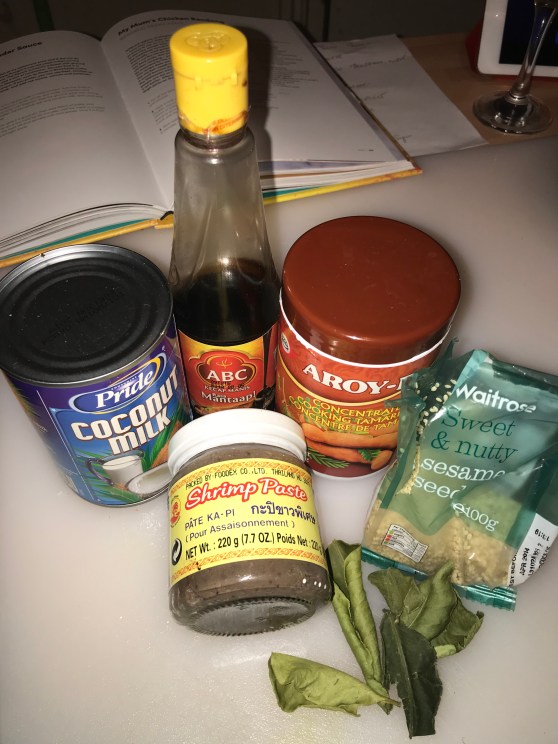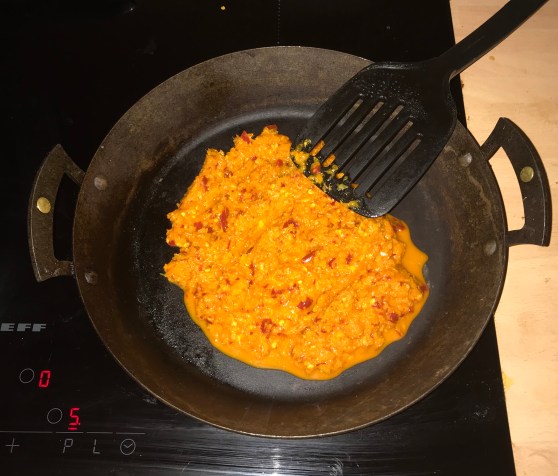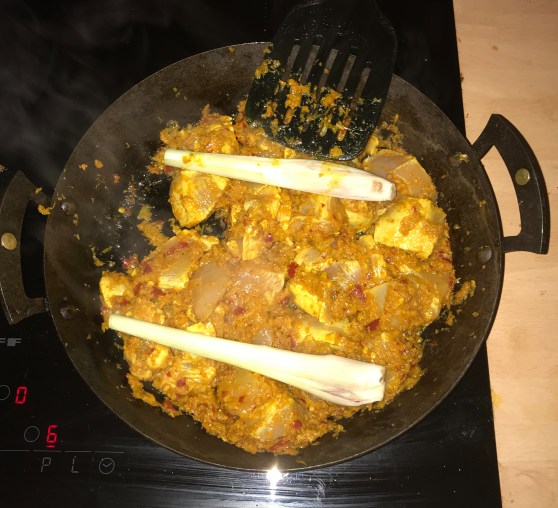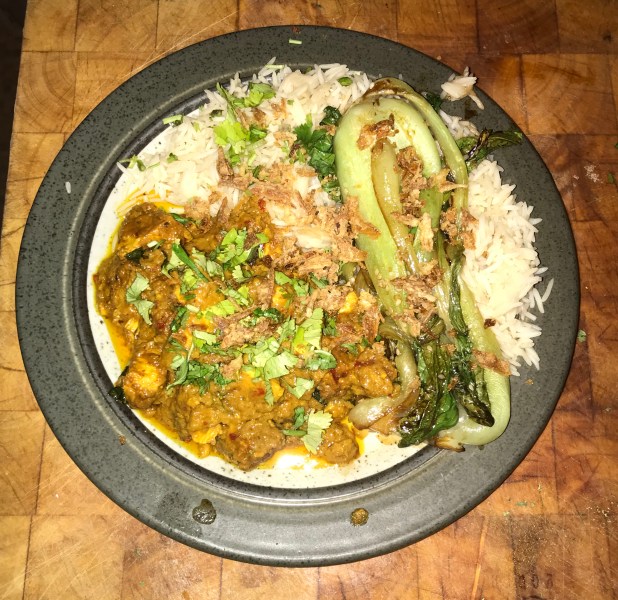 It did not take long after the trip to Malaysia to get the urge to cook something that would remind me of fun times. I have cooked ‘Rendang’ twice before, one at ‘Season Cookery School’ with the fabulous Jackie Kearney aka The Hungry Gecko of vegetarian and vegan food fame using Jackfruit, and previously I have attempted a Rendang using Beef Short Ribs which didn’t go quite right and needed more cooking.
It did not take long after the trip to Malaysia to get the urge to cook something that would remind me of fun times. I have cooked ‘Rendang’ twice before, one at ‘Season Cookery School’ with the fabulous Jackie Kearney aka The Hungry Gecko of vegetarian and vegan food fame using Jackfruit, and previously I have attempted a Rendang using Beef Short Ribs which didn’t go quite right and needed more cooking.
Norman Bin Musa is a bit of a super hero when it comes to Malaysian food and has won many awards and accolades for his skill and expertise in all things Malaysian. Honoured with being appointed the Kuala Lumpur Food Ambassador by the KL Mayor in 2015, and being featured on such programs as Toms Kerridge’s Best Ever Dishes and Channel 4’s Sunday Brunch he is a pretty damn fine Chef, winning such prizes as Chef of the Year at the Asian Curry Awards in 2012 and many more! I have several Malaysian cookery books in my ever growing collection, one being Normans’ ‘Amazing Malaysia’ it’s a cracking book and contains an authentic recipe for a Chicken Rendang, one his mother used to made so off to the Asian Supermarket for the ingredients and we were good to go.
I have several Malaysian cookery books in my ever growing collection, one being Normans’ ‘Amazing Malaysia’ it’s a cracking book and contains an authentic recipe for a Chicken Rendang, one his mother used to made so off to the Asian Supermarket for the ingredients and we were good to go. To accompany the Rendang I decided on plain Basmati Rice and Pak Choi, enhanced with some of the flavours above, Kecap Manis a Sweet Soy Sauce being one along with the Sesame Seeds to add some texture and crunch.
To accompany the Rendang I decided on plain Basmati Rice and Pak Choi, enhanced with some of the flavours above, Kecap Manis a Sweet Soy Sauce being one along with the Sesame Seeds to add some texture and crunch. A unique flavour to Malaysian cuisine is Kerisik which is grated, toasted and ground Coconut. The last time I made this I used a microwave oven, which worked but things got very hot indeed so this time I followed another method which involves melting some creamed coconut from a block, and cooking it in a saucepan until the right colour has been reached.
A unique flavour to Malaysian cuisine is Kerisik which is grated, toasted and ground Coconut. The last time I made this I used a microwave oven, which worked but things got very hot indeed so this time I followed another method which involves melting some creamed coconut from a block, and cooking it in a saucepan until the right colour has been reached. You can see the start and the end of the process in the pictures above. The aroma of Kerisik is like a ‘Toasty Caramel Coconut’ flavour and to me Is very unique in this style of cuisine. I am working on a dessert using Kerisik at the moment and have been publishing the ‘slow’ progress, it is heading in the right direction nicely though and the full version will get released when it’s completed over the next few months.
You can see the start and the end of the process in the pictures above. The aroma of Kerisik is like a ‘Toasty Caramel Coconut’ flavour and to me Is very unique in this style of cuisine. I am working on a dessert using Kerisik at the moment and have been publishing the ‘slow’ progress, it is heading in the right direction nicely though and the full version will get released when it’s completed over the next few months. The spice paste, once processed in the bender needs to be fried off, the deep orange colour is due to the fresh Turmeric I used, rather than powdered it’s more intense in both colour and flavour being very ‘earthy’! The recipe calls for 20 dried chilli’s soaked in water which might seem a lot, but the dish was not as hot as you might think.
The spice paste, once processed in the bender needs to be fried off, the deep orange colour is due to the fresh Turmeric I used, rather than powdered it’s more intense in both colour and flavour being very ‘earthy’! The recipe calls for 20 dried chilli’s soaked in water which might seem a lot, but the dish was not as hot as you might think. The Chicken is then added and given a good mix to cover the meat in the delicious spices, then some bruised Lemongrass to add some freshness, finally the Coconut Milk and the whole thing bubbles away until all is done.
The Chicken is then added and given a good mix to cover the meat in the delicious spices, then some bruised Lemongrass to add some freshness, finally the Coconut Milk and the whole thing bubbles away until all is done. The Tamarind, Kerisik and Kaffir Lime leafs are almost used as a seasoning, I found the dish needed more Tamarind to balance the flavours but that may just be my palate, it was a delicious dish with flavours dancing around on the tongue, I think the best Rendang I have done so far by a long way.
The Tamarind, Kerisik and Kaffir Lime leafs are almost used as a seasoning, I found the dish needed more Tamarind to balance the flavours but that may just be my palate, it was a delicious dish with flavours dancing around on the tongue, I think the best Rendang I have done so far by a long way. The Pak Choi is simply put into a saucepan with a little water and as it cooks add some Kecap Manis and sprinkle the Sesame Seeds. It only needs a few minutes to cook and adds a slightly bitter, irony dimension to the whole meal.
The Pak Choi is simply put into a saucepan with a little water and as it cooks add some Kecap Manis and sprinkle the Sesame Seeds. It only needs a few minutes to cook and adds a slightly bitter, irony dimension to the whole meal. If I had a New Years resolution, it would be to practise plating, and remember to wipe things clean before taking pictures but I usually end up just wanting to serve and eat, and things end up a bit rushed #musttryharder!!
If I had a New Years resolution, it would be to practise plating, and remember to wipe things clean before taking pictures but I usually end up just wanting to serve and eat, and things end up a bit rushed #musttryharder!!
I finished the plate with some Crispy Fried Onions and a sprinkling of Coriander and all was done. It’s a very tasty dish and quite easy to make if you have the ingredients to hand.
It’s worth investing in Norman’s book, there are lots of recipes that are quite simple to make as long as you read carefully and follow the text. At the back of the book there is a great chapter on ‘The Malaysian Storecupboard’ with pictures and details on the fresh and dried ingredients you will need.
So, Oca.
 In this weeks Organic Veg Box delivery there was a surprise, Oca, what the hell is Oca!! There was a description on the box and a quick look on the internet and all was clear, New Zealand Yam! Opening the box revealed some knobbly tuber like critters the size of a thumb, they can be eaten raw, as well as roasted or boiled like a Potato.
In this weeks Organic Veg Box delivery there was a surprise, Oca, what the hell is Oca!! There was a description on the box and a quick look on the internet and all was clear, New Zealand Yam! Opening the box revealed some knobbly tuber like critters the size of a thumb, they can be eaten raw, as well as roasted or boiled like a Potato. So I decided to cook some for tea just to see what they were like, not really expecting much as they don’t look particularly appetising, but how wrong that was to be!
So I decided to cook some for tea just to see what they were like, not really expecting much as they don’t look particularly appetising, but how wrong that was to be! I think it’s the Chef James Martin that says everything tastes better with Butter! In a small pan they went with some Oil and a bit of Butter, roasting for about 25 minutes and giving them a shake every 10 minutes to make sure they were cooked all the way through, then briefly drained on some kitchen paper.
I think it’s the Chef James Martin that says everything tastes better with Butter! In a small pan they went with some Oil and a bit of Butter, roasting for about 25 minutes and giving them a shake every 10 minutes to make sure they were cooked all the way through, then briefly drained on some kitchen paper. So, Oca, wow! They were absolutely delicious, slightly crispy on the outside, tender flesh in the middle, with a hint of lemon. I had noted some people commenting on there being no Lemon flavour, with ours it was definitely present, and very nice too. They could probably have been seasoned a bit harder with s touch more salt, but this is one vegetable I will be looking our for, thank-you Riverford Organic for introducing this fine produce to your customers.
So, Oca, wow! They were absolutely delicious, slightly crispy on the outside, tender flesh in the middle, with a hint of lemon. I had noted some people commenting on there being no Lemon flavour, with ours it was definitely present, and very nice too. They could probably have been seasoned a bit harder with s touch more salt, but this is one vegetable I will be looking our for, thank-you Riverford Organic for introducing this fine produce to your customers.
…………………….Until next time………………..L8ers………………




















































